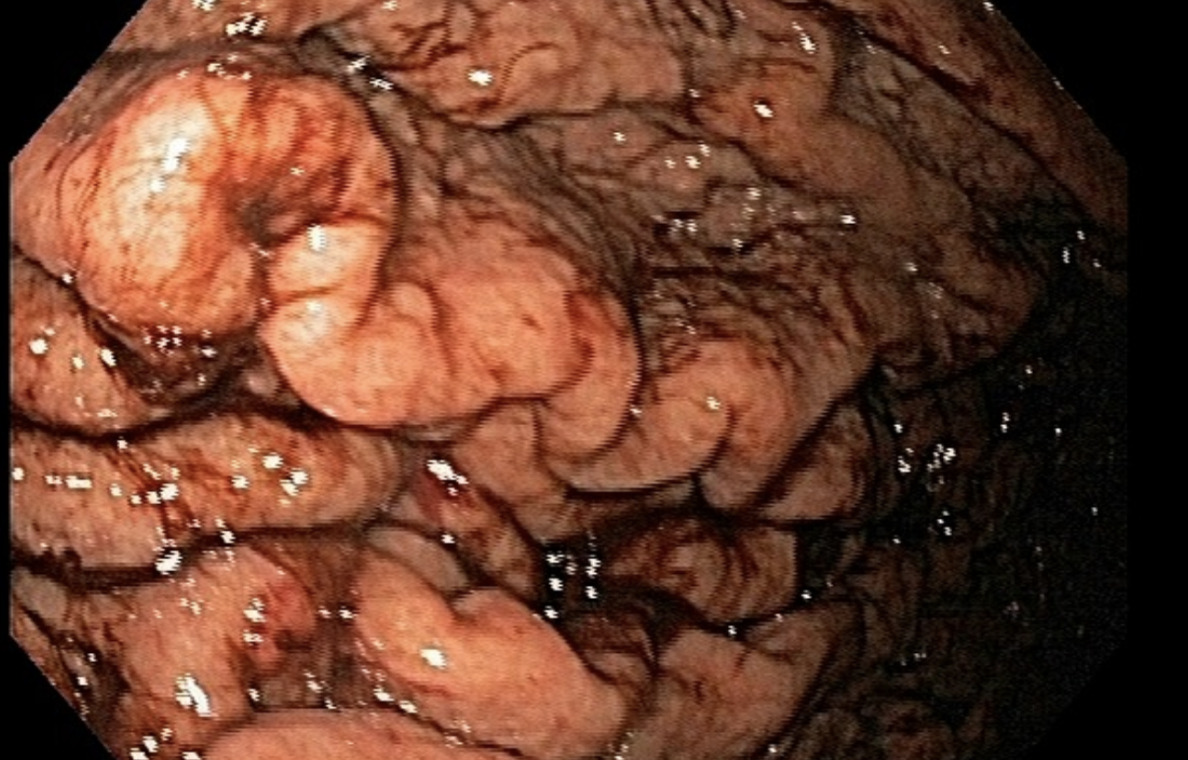Monday Poster Session
Category: Stomach and Spleen
P4248 - Unexplained Iron Deficiency Anemia Revealing Gastric Amyloid Deposition and Systemic AL Amyloidosis: A Case Report
Monday, October 27, 2025
10:30 AM - 4:00 PM PDT
Location: Exhibit Hall
- NM
Nancy Mayer, DO
Riverside Medical Center
Bourbonnais, IL
Presenting Author(s)
Nancy Mayer, DO1, Matthew Sutherland, DO1, Paul Kozak, DO1, Ashish Shah, MD2
1Riverside Medical Center, Bourbonnais, IL; 2Digestive Disease Consultants, Bourbonnais, IL
Introduction: Iron deficiency anemia (IDA) is a common clinical finding with a broad differential diagnosis, encompassing nutritional deficiencies, chronic blood loss, and malabsorptive disorders. However, in rare instances, IDA may serve as the initial manifestation of a more insidious systemic process. This case highlights an unusual presentation of systemic light-chain (AL) amyloidosis, in which IDA was the initial clinical clue leading to the diagnosis.
Case Description/
Methods: A 72-year-old male with a history of chronic heart failure with preserved ejection fraction was referred to the gastroenterology clinic for evaluation of progressive anemia. Over the previous three months, his hemoglobin levels had declined steadily, reaching a low of 11.2 g/dL. Iron studies were consistent with IDA. The patient denied overt gastrointestinal bleeding but endorsed darker stools with regular frequency and consistency. An esophagogastroduodenoscopy revealed diffuse gastric mucosal erythema, erosions, and friability, suggestive of hemorrhagic gastritis. Biopsies of the gastric antrum were negative for Helicobacter pylori, but Congo red staining identified amyloid deposits. Further workup showed elevated serum lambda light chains. A bone marrow biopsy revealed a kappa-restricted plasma cell neoplasm, and endomyocardial biopsy confirmed the diagnosis of AL amyloidosis with cardiac involvement.
Discussion: Gastrointestinal involvement occurs in approximately 3% of patients with systemic amyloidosis.1 When present, gastrointestinal amyloidosis commonly manifests as altered bowel habits, weight loss, mechanical obstruction, or gastrointestinal hemorrhage. Presentation as IDA, particularly in the absence of overt bleeding, is exceptionally rare. The proposed mechanism involves amyloid fibril deposition in the lamina propria and small blood vessels, leading to compromised mucosal integrity and blood loss, and potentially impaired iron absorption.2 In this patient, IDA served as the initial manifestation of a systemic disease process that was ultimately found to involve both the gastrointestinal and cardiac systems. This case underscores the importance of maintaining a broad differential diagnosis in patients with unexplained iron deficiency anemia, particularly in the setting of comorbidities affecting other organ systems. Increased awareness that iron deficiency may be the first manifestation of amyloidosis, combined with timely endoscopic biopsies, can facilitate earlier diagnosis and therapeutic intervention.

Figure: Diffuse gastric mucosal erythema, erosions, and friability consistent with hemorrhagic gastritis.
Disclosures:
Nancy Mayer indicated no relevant financial relationships.
Matthew Sutherland indicated no relevant financial relationships.
Paul Kozak indicated no relevant financial relationships.
Ashish Shah indicated no relevant financial relationships.
Nancy Mayer, DO1, Matthew Sutherland, DO1, Paul Kozak, DO1, Ashish Shah, MD2. P4248 - Unexplained Iron Deficiency Anemia Revealing Gastric Amyloid Deposition and Systemic AL Amyloidosis: A Case Report, ACG 2025 Annual Scientific Meeting Abstracts. Phoenix, AZ: American College of Gastroenterology.
1Riverside Medical Center, Bourbonnais, IL; 2Digestive Disease Consultants, Bourbonnais, IL
Introduction: Iron deficiency anemia (IDA) is a common clinical finding with a broad differential diagnosis, encompassing nutritional deficiencies, chronic blood loss, and malabsorptive disorders. However, in rare instances, IDA may serve as the initial manifestation of a more insidious systemic process. This case highlights an unusual presentation of systemic light-chain (AL) amyloidosis, in which IDA was the initial clinical clue leading to the diagnosis.
Case Description/
Methods: A 72-year-old male with a history of chronic heart failure with preserved ejection fraction was referred to the gastroenterology clinic for evaluation of progressive anemia. Over the previous three months, his hemoglobin levels had declined steadily, reaching a low of 11.2 g/dL. Iron studies were consistent with IDA. The patient denied overt gastrointestinal bleeding but endorsed darker stools with regular frequency and consistency. An esophagogastroduodenoscopy revealed diffuse gastric mucosal erythema, erosions, and friability, suggestive of hemorrhagic gastritis. Biopsies of the gastric antrum were negative for Helicobacter pylori, but Congo red staining identified amyloid deposits. Further workup showed elevated serum lambda light chains. A bone marrow biopsy revealed a kappa-restricted plasma cell neoplasm, and endomyocardial biopsy confirmed the diagnosis of AL amyloidosis with cardiac involvement.
Discussion: Gastrointestinal involvement occurs in approximately 3% of patients with systemic amyloidosis.1 When present, gastrointestinal amyloidosis commonly manifests as altered bowel habits, weight loss, mechanical obstruction, or gastrointestinal hemorrhage. Presentation as IDA, particularly in the absence of overt bleeding, is exceptionally rare. The proposed mechanism involves amyloid fibril deposition in the lamina propria and small blood vessels, leading to compromised mucosal integrity and blood loss, and potentially impaired iron absorption.2 In this patient, IDA served as the initial manifestation of a systemic disease process that was ultimately found to involve both the gastrointestinal and cardiac systems. This case underscores the importance of maintaining a broad differential diagnosis in patients with unexplained iron deficiency anemia, particularly in the setting of comorbidities affecting other organ systems. Increased awareness that iron deficiency may be the first manifestation of amyloidosis, combined with timely endoscopic biopsies, can facilitate earlier diagnosis and therapeutic intervention.

Figure: Diffuse gastric mucosal erythema, erosions, and friability consistent with hemorrhagic gastritis.
Disclosures:
Nancy Mayer indicated no relevant financial relationships.
Matthew Sutherland indicated no relevant financial relationships.
Paul Kozak indicated no relevant financial relationships.
Ashish Shah indicated no relevant financial relationships.
Nancy Mayer, DO1, Matthew Sutherland, DO1, Paul Kozak, DO1, Ashish Shah, MD2. P4248 - Unexplained Iron Deficiency Anemia Revealing Gastric Amyloid Deposition and Systemic AL Amyloidosis: A Case Report, ACG 2025 Annual Scientific Meeting Abstracts. Phoenix, AZ: American College of Gastroenterology.
